JEEP GRAND CHEROKEE 2018 Owner handbook (in English)
Manufacturer: JEEP, Model Year: 2018, Model line: GRAND CHEROKEE, Model: JEEP GRAND CHEROKEE 2018Pages: 368, PDF Size: 5.72 MB
Page 271 of 368
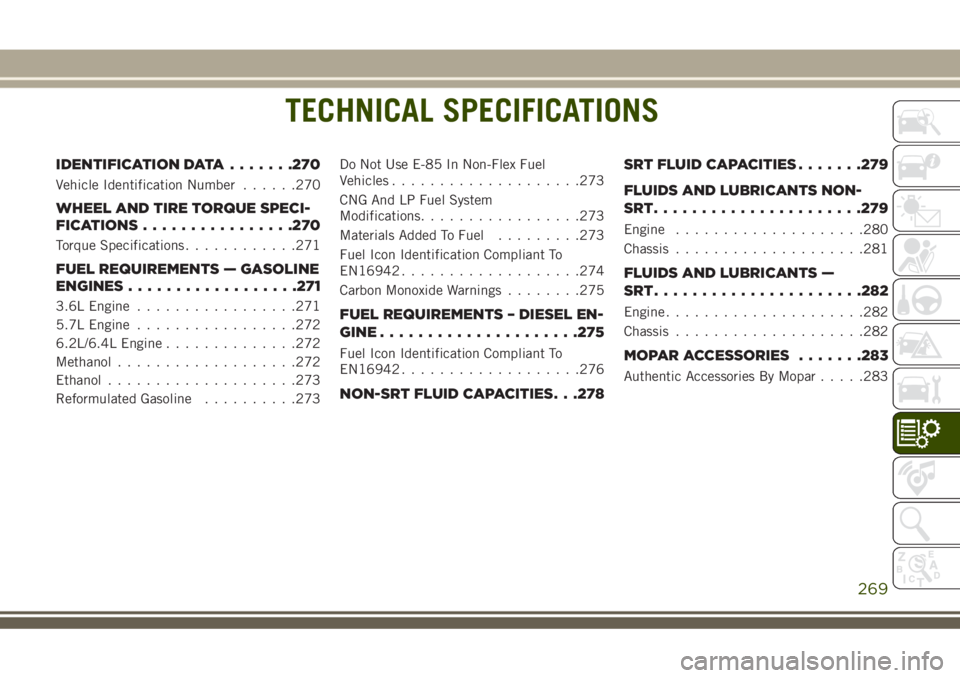
TECHNICAL SPECIFICATIONS
IDENTIFICATION DATA.......270
Vehicle Identification Number......270
WHEEL AND TIRE TORQUE SPECI-
FICATIONS................270
Torque Specifications............271
FUEL REQUIREMENTS — GASOLINE
ENGINES..................271
3.6L Engine.................271
5.7L Engine.................272
6.2L/6.4L Engine..............272
Methanol...................272
Ethanol....................273
Reformulated Gasoline..........273Do Not Use E-85 In Non-Flex Fuel
Vehicles....................273
CNG And LP Fuel System
Modifications.................273
Materials Added To Fuel.........273
Fuel Icon Identification Compliant To
EN16942...................274
Carbon Monoxide Warnings........275FUEL REQUIREMENTS – DIESEL EN-
GINE.....................275
Fuel Icon Identification Compliant To
EN16942...................276
NON-SRT FLUID CAPACITIES. . .278SRT FLUID CAPACITIES.......279
FLUIDS AND LUBRICANTS NON-
SRT......................279
Engine....................280
Chassis....................281
FLUIDS AND LUBRICANTS —
SRT......................282
Engine.....................282
Chassis....................282
MOPAR ACCESSORIES.......283
Authentic Accessories By Mopar.....283
TECHNICAL SPECIFICATIONS
269
Page 272 of 368
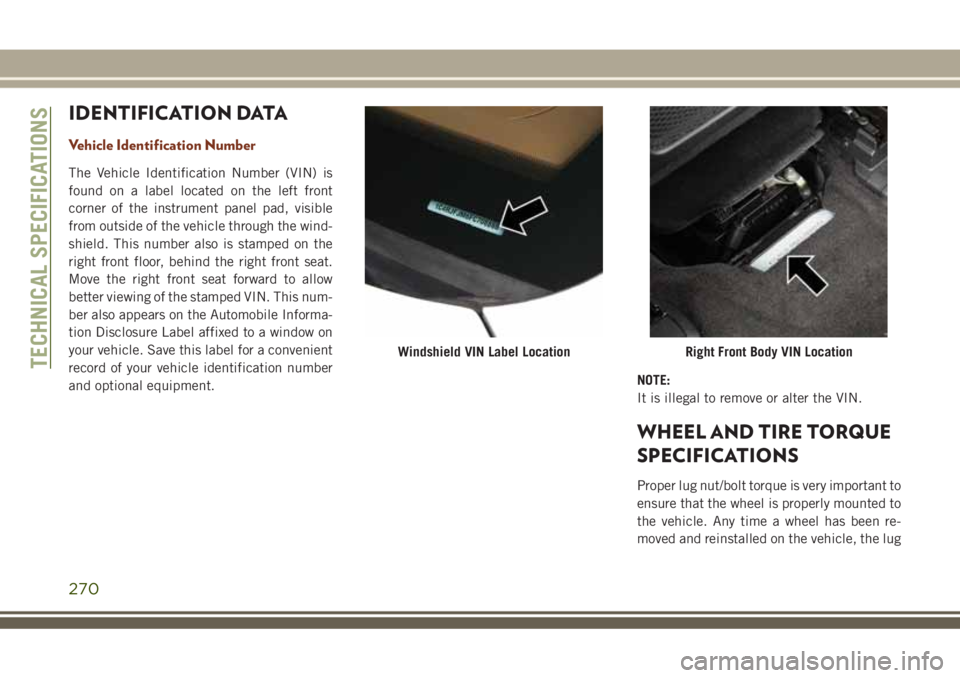
IDENTIFICATION DATA
Vehicle Identification Number
The Vehicle Identification Number (VIN) is
found on a label located on the left front
corner of the instrument panel pad, visible
from outside of the vehicle through the wind-
shield. This number also is stamped on the
right front floor, behind the right front seat.
Move the right front seat forward to allow
better viewing of the stamped VIN. This num-
ber also appears on the Automobile Informa-
tion Disclosure Label affixed to a window on
your vehicle. Save this label for a convenient
record of your vehicle identification number
and optional equipment.NOTE:
It is illegal to remove or alter the VIN.
WHEEL AND TIRE TORQUE
SPECIFICATIONS
Proper lug nut/bolt torque is very important to
ensure that the wheel is properly mounted to
the vehicle. Any time a wheel has been re-
moved and reinstalled on the vehicle, the lug
Windshield VIN Label LocationRight Front Body VIN LocationTECHNICAL SPECIFICATIONS
270
Page 273 of 368
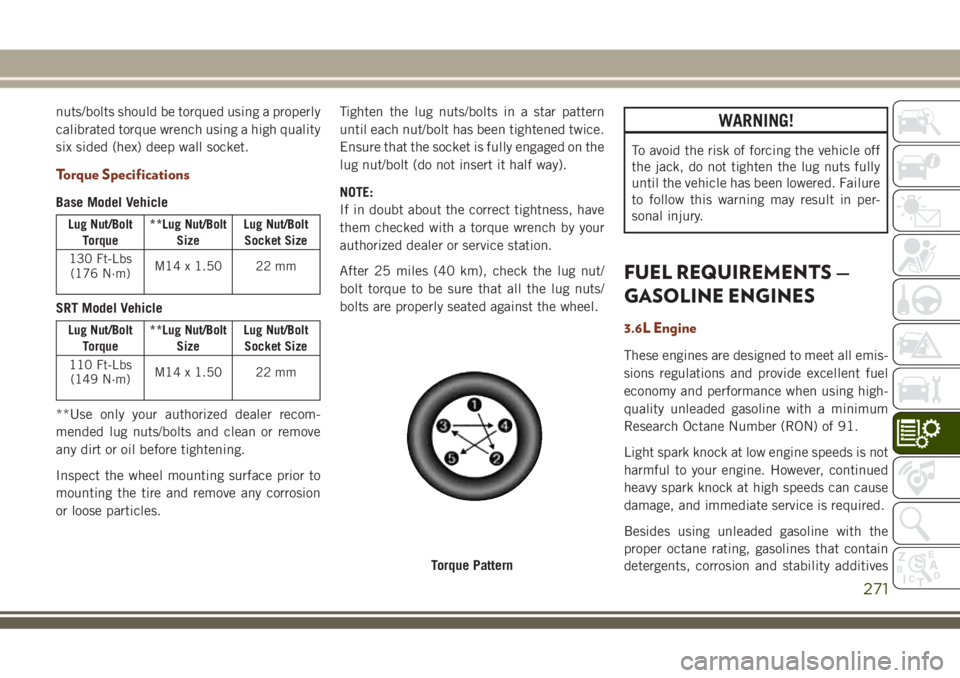
nuts/bolts should be torqued using a properly
calibrated torque wrench using a high quality
six sided (hex) deep wall socket.
Torque Specifications
Base Model Vehicle
Lug Nut/Bolt
Torque**Lug Nut/Bolt
SizeLug Nut/Bolt
Socket Size
130 Ft-Lbs
(176 N·m)M14 x 1.50 22 mm
SRT Model Vehicle
Lug Nut/Bolt
Torque**Lug Nut/Bolt
SizeLug Nut/Bolt
Socket Size
110 Ft-Lbs
(149 N·m)M14 x 1.50 22 mm
**Use only your authorized dealer recom-
mended lug nuts/bolts and clean or remove
any dirt or oil before tightening.
Inspect the wheel mounting surface prior to
mounting the tire and remove any corrosion
or loose particles.Tighten the lug nuts/bolts in a star pattern
until each nut/bolt has been tightened twice.
Ensure that the socket is fully engaged on the
lug nut/bolt (do not insert it half way).
NOTE:
If in doubt about the correct tightness, have
them checked with a torque wrench by your
authorized dealer or service station.
After 25 miles (40 km), check the lug nut/
bolt torque to be sure that all the lug nuts/
bolts are properly seated against the wheel.
WARNING!
To avoid the risk of forcing the vehicle off
the jack, do not tighten the lug nuts fully
until the vehicle has been lowered. Failure
to follow this warning may result in per-
sonal injury.
FUEL REQUIREMENTS —
GASOLINE ENGINES
3.6L Engine
These engines are designed to meet all emis-
sions regulations and provide excellent fuel
economy and performance when using high-
quality unleaded gasoline with a minimum
Research Octane Number (RON) of 91.
Light spark knock at low engine speeds is not
harmful to your engine. However, continued
heavy spark knock at high speeds can cause
damage, and immediate service is required.
Besides using unleaded gasoline with the
proper octane rating, gasolines that contain
detergents, corrosion and stability additives
Torque Pattern
271
Page 274 of 368
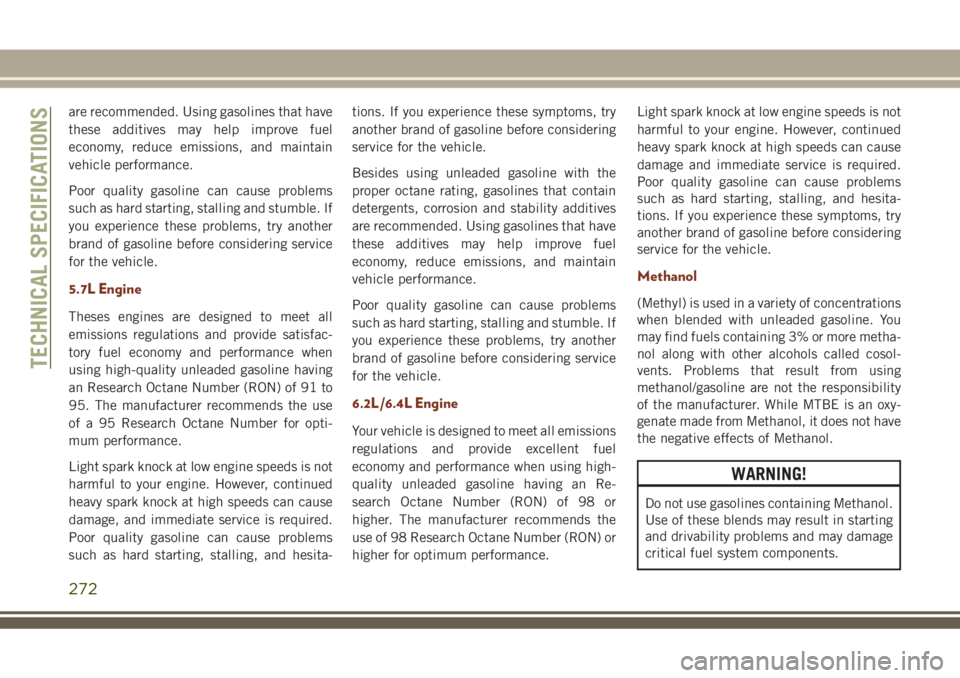
are recommended. Using gasolines that have
these additives may help improve fuel
economy, reduce emissions, and maintain
vehicle performance.
Poor quality gasoline can cause problems
such as hard starting, stalling and stumble. If
you experience these problems, try another
brand of gasoline before considering service
for the vehicle.
5.7L Engine
Theses engines are designed to meet all
emissions regulations and provide satisfac-
tory fuel economy and performance when
using high-quality unleaded gasoline having
an Research Octane Number (RON) of 91 to
95. The manufacturer recommends the use
of a 95 Research Octane Number for opti-
mum performance.
Light spark knock at low engine speeds is not
harmful to your engine. However, continued
heavy spark knock at high speeds can cause
damage, and immediate service is required.
Poor quality gasoline can cause problems
such as hard starting, stalling, and hesita-tions. If you experience these symptoms, try
another brand of gasoline before considering
service for the vehicle.
Besides using unleaded gasoline with the
proper octane rating, gasolines that contain
detergents, corrosion and stability additives
are recommended. Using gasolines that have
these additives may help improve fuel
economy, reduce emissions, and maintain
vehicle performance.
Poor quality gasoline can cause problems
such as hard starting, stalling and stumble. If
you experience these problems, try another
brand of gasoline before considering service
for the vehicle.
6.2L/6.4L Engine
Your vehicle is designed to meet all emissions
regulations and provide excellent fuel
economy and performance when using high-
quality unleaded gasoline having an Re-
search Octane Number (RON) of 98 or
higher. The manufacturer recommends the
use of 98 Research Octane Number (RON) or
higher for optimum performance.Light spark knock at low engine speeds is not
harmful to your engine. However, continued
heavy spark knock at high speeds can cause
damage and immediate service is required.
Poor quality gasoline can cause problems
such as hard starting, stalling, and hesita-
tions. If you experience these symptoms, try
another brand of gasoline before considering
service for the vehicle.
Methanol
(Methyl) is used in a variety of concentrations
when blended with unleaded gasoline. You
may find fuels containing 3% or more metha-
nol along with other alcohols called cosol-
vents. Problems that result from using
methanol/gasoline are not the responsibility
of the manufacturer. While MTBE is an oxy-
genate made from Methanol, it does not have
the negative effects of Methanol.
WARNING!
Do not use gasolines containing Methanol.
Use of these blends may result in starting
and drivability problems and may damage
critical fuel system components.
TECHNICAL SPECIFICATIONS
272
Page 275 of 368

Ethanol
The manufacturer recommends that your ve-
hicle be operated on fuel containing no more
than 15% ethanol. Purchasing your fuel from
a reputable supplier may reduce the risk of
exceeding this 15% limit and/or of receiving
fuel with abnormal properties. It should also
be noted that an increase in fuel consump-
tion should be expected when using ethanol-
blended fuels, due to the lower energy con-
tent of ethanol. Problems that result from
using methanol/gasoline or E-85 ethanol
blends are not the responsibility of the
manufacturer.
CAUTION!
Use of fuel with Ethanol content higher
than 15% may result in engine malfunc-
tion, starting and operating difficulties,
and materials degradation. These adverse
effects could result in permanent damage
to your vehicle.
Reformulated Gasoline
Many areas of the country require the use of
cleaner burning gasoline referred to as “Re-
formulated Gasoline”. Reformulated gasoline
contains oxygenates and are specifically
blended to reduce vehicle emissions and im-
prove air quality.
The use of reformulated gasoline is recom-
mended. Properly blended reformulated
gasoline will provide improved performance
and durability of engine and fuel system
components.
Do Not Use E-85 In Non-Flex Fuel
Vehicles
Non-Flex Fuel Vehicles (FFV) are compatible
with gasoline containing up to 15% ethanol
(E-15). Use of gasoline with higher ethanol
content may void the New Vehicle Limited
Warranty.
If a Non-FFV vehicle is inadvertently fueled
with E-85 fuel, the engine will have some or
all of these symptoms:
• Operate in a lean mode.
• OBD II “Malfunction Indicator Light” on.• Poor engine performance.
• Poor cold start and cold drivability.
• Increased risk for fuel system component
corrosion.
CNG And LP Fuel System Modifications
Modifications that allow the engine to run on
compressed natural gas (CNG) or liquid pro-
pane (LP) may result in damage to the en-
gine, emissions, and fuel system compo-
nents. Problems that result from running
CNG or LP are not the responsibility of the
manufacturer and may void or not be covered
under the New Vehicle Limited Warranty.
Materials Added To Fuel
Indiscriminate use of fuel system cleaning
agents should be avoided. Many of these
materials intended for gum and varnish re-
moval may contain active solvents or similar
ingredients. These can harm fuel system gas-
ket and diaphragm materials.
273
Page 276 of 368

Fuel Icon Identification Compliant To EN16942
Fuel IconsWhat It Means
E5Unleaded fuel containing up to 2,7 % (m/m) oxygen and a maximum ethanol content of 5,0 % (V/V)EN228compliant
fuel
E10Unleaded fuel containing up to 3,7 % (m/m) oxygen and a maximum ethanol content of 10,0 % (V/V)EN228compliant
fuel
Compressed Natural Gas and biomethane for automotive applicationsEN16723compliant fuel
Liquefied Petroleum Gas for automotive applicationsEN589compliant fuel
TECHNICAL SPECIFICATIONS
274
Page 277 of 368
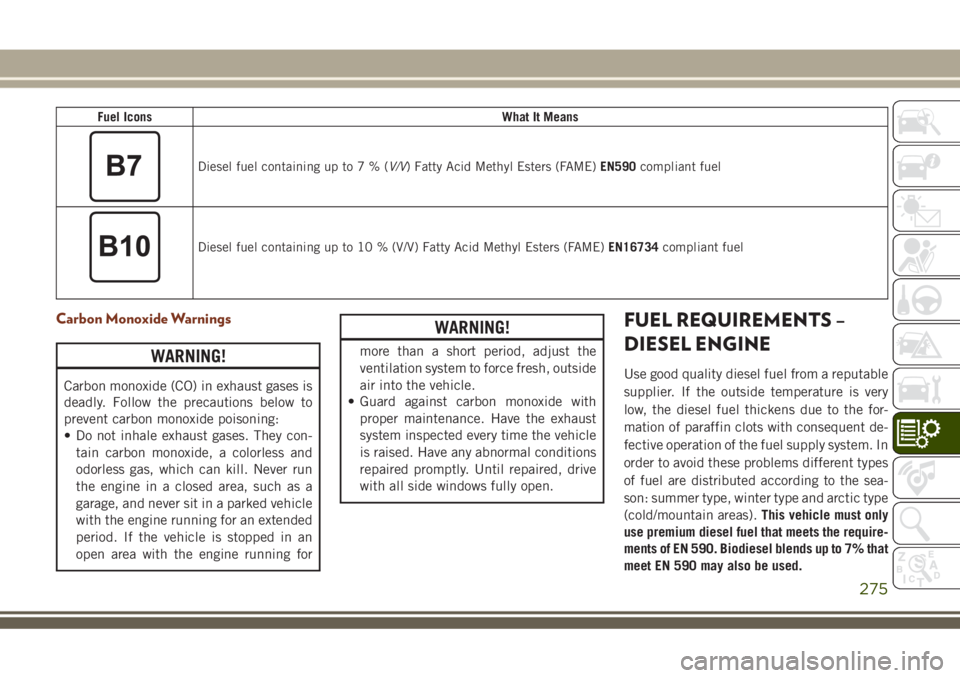
Fuel IconsWhat It Means
Diesel fuel containing up to7%(V/V) Fatty Acid Methyl Esters (FAME)EN590compliant fuel
Diesel fuel containing up to 10 % (V/V) Fatty Acid Methyl Esters (FAME)EN16734compliant fuel
Carbon Monoxide Warnings
WARNING!
Carbon monoxide (CO) in exhaust gases is
deadly. Follow the precautions below to
prevent carbon monoxide poisoning:
• Do not inhale exhaust gases. They con-
tain carbon monoxide, a colorless and
odorless gas, which can kill. Never run
the engine in a closed area, such as a
garage, and never sit in a parked vehicle
with the engine running for an extended
period. If the vehicle is stopped in an
open area with the engine running for
WARNING!
more than a short period, adjust the
ventilation system to force fresh, outside
air into the vehicle.
• Guard against carbon monoxide with
proper maintenance. Have the exhaust
system inspected every time the vehicle
is raised. Have any abnormal conditions
repaired promptly. Until repaired, drive
with all side windows fully open.
FUEL REQUIREMENTS –
DIESEL ENGINE
Use good quality diesel fuel from a reputable
supplier. If the outside temperature is very
low, the diesel fuel thickens due to the for-
mation of paraffin clots with consequent de-
fective operation of the fuel supply system. In
order to avoid these problems different types
of fuel are distributed according to the sea-
son: summer type, winter type and arctic type
(cold/mountain areas).This vehicle must only
use premium diesel fuel that meets the require-
ments of EN 590. Biodiesel blends up to 7% that
meet EN 590 may also be used.
275
Page 278 of 368
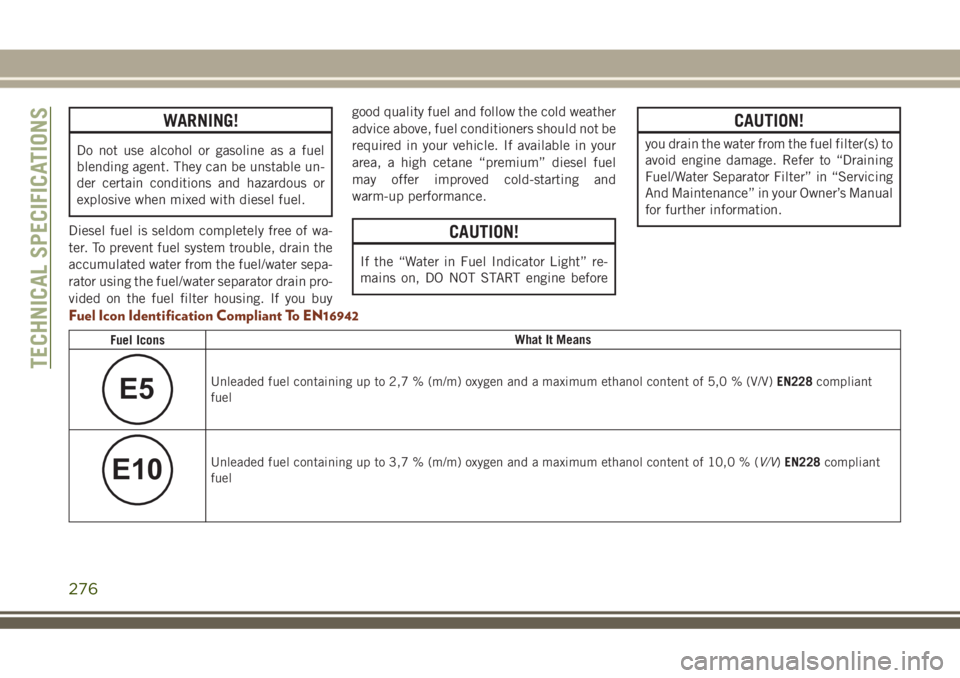
WARNING!
Do not use alcohol or gasoline as a fuel
blending agent. They can be unstable un-
der certain conditions and hazardous or
explosive when mixed with diesel fuel.
Diesel fuel is seldom completely free of wa-
ter. To prevent fuel system trouble, drain the
accumulated water from the fuel/water sepa-
rator using the fuel/water separator drain pro-
vided on the fuel filter housing. If you buygood quality fuel and follow the cold weather
advice above, fuel conditioners should not be
required in your vehicle. If available in your
area, a high cetane “premium” diesel fuel
may offer improved cold-starting and
warm-up performance.
CAUTION!
If the “Water in Fuel Indicator Light” re-
mains on, DO NOT START engine before
CAUTION!
you drain the water from the fuel filter(s) to
avoid engine damage. Refer to “Draining
Fuel/Water Separator Filter” in “Servicing
And Maintenance” in your Owner’s Manual
for further information.
Fuel Icon Identification Compliant To EN16942
Fuel IconsWhat It Means
E5Unleaded fuel containing up to 2,7 % (m/m) oxygen and a maximum ethanol content of 5,0 % (V/V)EN228compliant
fuel
E10Unleaded fuel containing up to 3,7 % (m/m) oxygen and a maximum ethanol content of 10,0 % (V/V)EN228compliant
fuel
TECHNICAL SPECIFICATIONS
276
Page 279 of 368
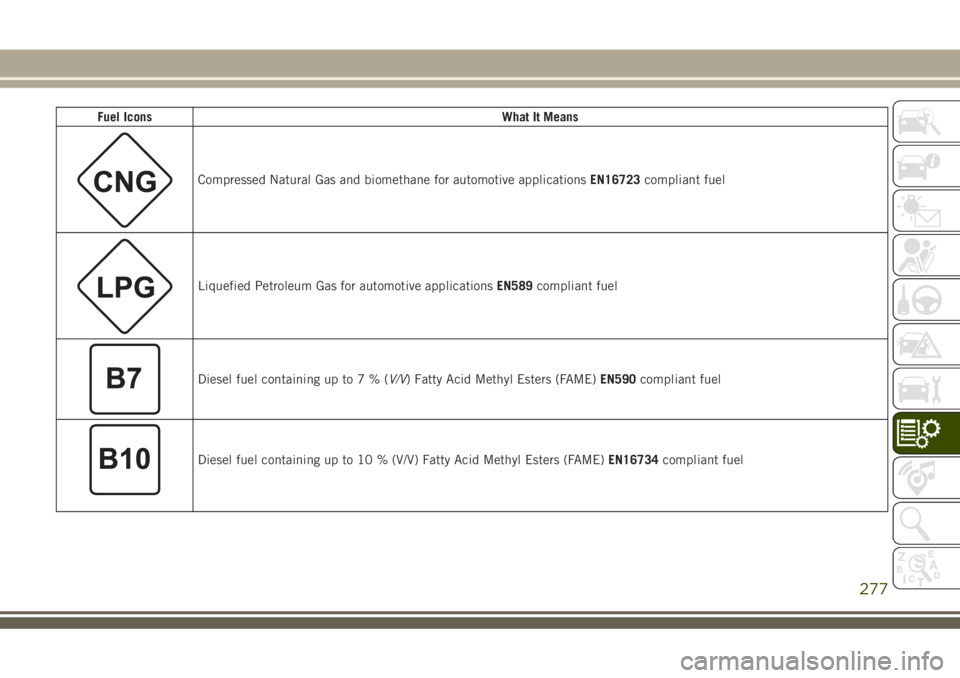
Fuel IconsWhat It Means
Compressed Natural Gas and biomethane for automotive applicationsEN16723compliant fuel
Liquefied Petroleum Gas for automotive applicationsEN589compliant fuel
Diesel fuel containing up to7%(V/V) Fatty Acid Methyl Esters (FAME)EN590compliant fuel
Diesel fuel containing up to 10 % (V/V) Fatty Acid Methyl Esters (FAME)EN16734compliant fuel
277
Page 280 of 368
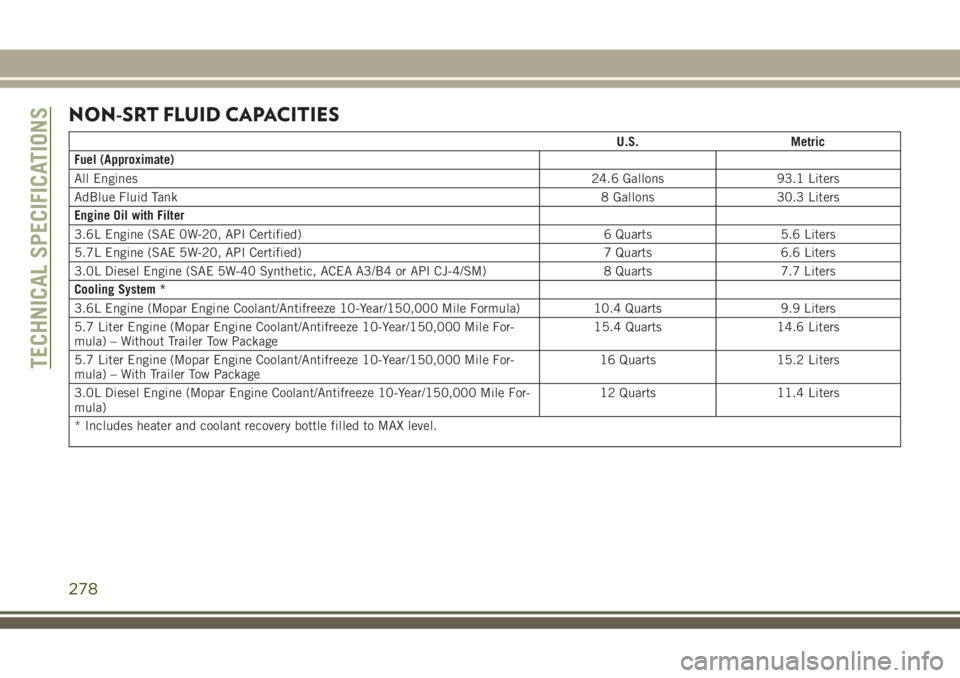
NON-SRT FLUID CAPACITIES
U.S. Metric
Fuel (Approximate)
All Engines24.6 Gallons 93.1 Liters
AdBlue Fluid Tank8 Gallons 30.3 Liters
Engine Oil with Filter
3.6L Engine (SAE 0W-20, API Certified) 6 Quarts 5.6 Liters
5.7L Engine (SAE 5W-20, API Certified) 7 Quarts 6.6 Liters
3.0L Diesel Engine (SAE 5W-40 Synthetic, ACEA A3/B4 or API CJ-4/SM) 8 Quarts 7.7 Liters
Cooling System *
3.6L Engine (Mopar Engine Coolant/Antifreeze 10-Year/150,000 Mile Formula) 10.4 Quarts 9.9 Liters
5.7 Liter Engine (Mopar Engine Coolant/Antifreeze 10-Year/150,000 Mile For-
mula) – Without Trailer Tow Package15.4 Quarts 14.6 Liters
5.7 Liter Engine (Mopar Engine Coolant/Antifreeze 10-Year/150,000 Mile For-
mula) – With Trailer Tow Package16 Quarts 15.2 Liters
3.0L Diesel Engine (Mopar Engine Coolant/Antifreeze 10-Year/150,000 Mile For-
mula)12 Quarts 11.4 Liters
* Includes heater and coolant recovery bottle filled to MAX level.
TECHNICAL SPECIFICATIONS
278